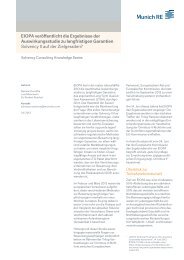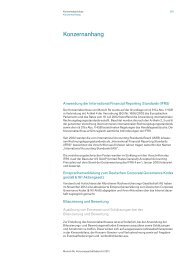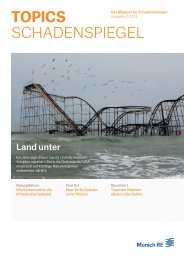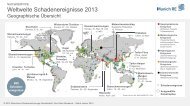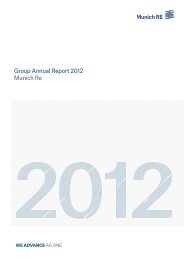Munich Re Group Annual Report 2006 (PDF, 1.8
Munich Re Group Annual Report 2006 (PDF, 1.8
Munich Re Group Annual Report 2006 (PDF, 1.8
Create successful ePaper yourself
Turn your PDF publications into a flip-book with our unique Google optimized e-Paper software.
<strong>Munich</strong> <strong>Re</strong> <strong>Group</strong> <strong>Annual</strong> <strong>Re</strong>port <strong>2006</strong> General information_Glossary<br />
L – O<br />
Life and health<br />
One of the segments in our segment reporting, containing the<br />
classes life (re)insurance and health (re)insurance.<br />
Loss ratio<br />
Percentage ratio of claims expenses to earned premiums.<br />
Marine<br />
The insurance of ships and their cargoes.<br />
Market value<br />
The publicly listed market price obtainable for an asset in an active<br />
market (especially stock market price).<br />
Medicator<br />
Medicator AG is the German private health insurers’ fund for the protection<br />
of policyholders. It guarantees that a health insurance company’s<br />
contractual obligations will be fulfilled in the event that the<br />
company encounters financial difficulties.<br />
Minority interests in equity and earnings<br />
That part of the equity and earnings of subsidiaries that is attributable<br />
to shareholders outside the <strong>Group</strong>.<br />
Mortality table<br />
Table developed using methods of probability theory for estimating<br />
the expected mortality of policyholders in a portfolio of life or health<br />
insurance contracts. It shows the probability of future mortality on a<br />
differentiated basis according to age and other factors, often taking<br />
into account demographic trends. Mortality tables with provision for<br />
adverse deviation are generally used for measuring technical provisions.<br />
Net<br />
Gross/net<br />
Net asset value<br />
Measurement of the fair value of companies. The starting point is<br />
the proportional equity capital of the company to be valued, plus the<br />
valuation reserves.<br />
Net expenses for claims and benefits<br />
These include the expenses for claims (claims payments and the<br />
change in the provision for outstanding claims), expenses for premium<br />
refunds and the change in the remaining technical provisions<br />
(provision for future policy benefits and other), in each case after<br />
deduction of the ceded share.<br />
Net operating expenses<br />
Commission, personnel costs and general expenses for the acquisition<br />
and ongoing administration of insurance contracts, less any<br />
commission reimbursed by reinsurers, including profit commission,<br />
plus expenses from amortisation of PVFP.<br />
Net premium<br />
Amount relevant for determining the provision for future policy<br />
benefits as per FAS 120. The net premium derives from the gross<br />
premium less the premium portions used to amortise the acquisition<br />
costs.<br />
Non-proportional reinsurance<br />
Under this form of reinsurance, the reinsurer assumes payment of<br />
the primary insurer’s loss above a defined amount. The calculation of<br />
the reinsurance premium is based on claims experience with the<br />
type of business concerned.<br />
Obligatory reinsurance<br />
Although obligatory reinsurance agreements contain agreed periods<br />
of notice, they are generally concluded for an unlimited duration.<br />
These treaties between insurers and reinsurers may therefore run for<br />
long periods (cf. facultative reinsurance).<br />
Offshore energy insurance<br />
Umbrella term for the insurance of risks such as oil platforms and<br />
production facilities at sea, plus the related technical equipment.<br />
Operating result before taxes on income<br />
Consolidated result from ordinary activities, before finance costs and<br />
taxes on income.<br />
Option<br />
Derivative financial instrument where the holder is entitled – but not<br />
obliged – to buy (in the case of a call option) or sell (in the case of a<br />
put option) the underlying asset at a predetermined price within a<br />
certain period. The writer of the option is obliged to transfer or buy<br />
the asset and receives a premium for granting the option to the purchaser.<br />
OTC derivative<br />
Derivative financial instrument which is not standardised and is<br />
traded not on an exchange but directly between two counterparties<br />
via over-the-counter (OTC) transactions.<br />
223



